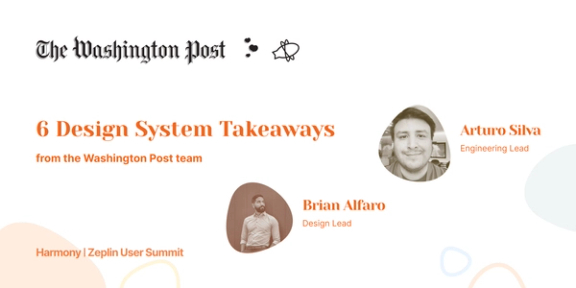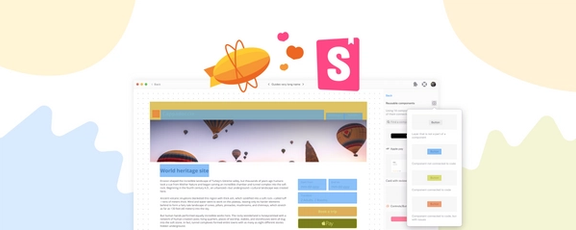Anyone who works in development can tell you one of the biggest struggles to overcome in their day-to-day work life is handoff challenges between designers and developers. The endless back-and-forth to ensure everyone is on the same page gets old quickly. The two teams are equally vital to the outcome of the final product, yet barriers to communication and lack of understanding cause hiccups during handoff.
Delivering designs comes with problems like a lack of clarity on which version is final, confusion on the layout of screens and artboards, unclear design intention, and siloed design systems — not to mention how confusing design software can be for non-designers. Automating the handoff process removes these challenges, saving time to let the design and development departments focus on more important tasks (and usually, more interesting ones). With the right technology, design handoff becomes seamless and easy for the entire team, making constant back-and-forth a thing of the past.
1. Access version history and know which version is final
Every developer knows the all-too-common problem of trying to determine which version the designer shared with you is the final version. Designers often work iteratively, so the latest version might not actually be the final version. With Zeplin’s version history, a developer can see exactly what has changed. This helps to eliminate endless messages to double- and triple-check the design is ready for development that can eat up valuable time both teams could be spending on their projects — not to mention cause plenty of headaches for all involved.
Designers can easily communicate which file should be developed by “locking” designs. Once the design team has published the design into Zeplin for other collaborators to see, the design is then locked and no more edits can be made. This way, development knows they are looking at the finalized design, removing any risk of unintended versions going live. By utilizing technology like Zeplin, designed for seamless handoff, any confusion surrounding version finality can be eliminated once and for all (and you’ll never have to send a “Is this version final?” message again!).
2. Utilize a design system to align design and development
As important as finalization is, it doesn’t go very far unless the design and development teams are on the same page. Designers utilize style guides and pattern libraries to align their team internally, with guidelines on everything from colors and fonts to design elements. However, these systems end once the designs are pushed out to development, resulting in gaps in brand consistency that further handoff challenges for both teams. Building out a shared language with a design system makes working within design parameters easy for development. With frequently used design elements readily available — such as buttons, text fields, icons, and even defined proper use of each — ensuring the final product works within the brand’s style is a breeze.
Zeplin seamlessly integrates the design system used by designers with the codebase used by developers. Connecting design components to code not only ensures consistent branding but lets developers know which components are reusable. This reduces time wasted on redesigning and rebuilding from scratch. Empowered with a design system, the design and development teams — along with the rest of the product team — get the context, understanding, and meaning behind all designs and intent. Never again will non-designers wonder what element to use or how! 🔥
3. Save time with automatically generated specs
Knowing what’s ready for development is just the beginning. Once the design is final, developers need the exact specs of the design’s individual elements to properly create functionality. This leads to additional steps to locate, understand, and organize the data provided by the design software, eating into the time developers could spend actually building the functionality.
With four project types to choose from, Zeplin instantly saves time by automatically generating specs on each element of a design, giving developers the exact sizing information they need to know for macOS, web, iOS, or Android. With platform-specific resources, optimized assets and community-driven code snippets, this means no more switching between tools to get custom settings.
Developers can easily access the exact information they need to inform functionality, meaning that once the design team uploads their final version, they can move on to the next task — and so can development. Eliminating this back-and-forth speeds up the entire development process — 66% of designers spend 4-8 hours per week explaining design layout, while 65% of developers spend 4-8 hours per week interpreting it. Automatically generated specs save hours of time for each team member (yes, you read that right).
4. Minimize handoff challenges with a design delivery approach
While design and development work in tandem to create, their work styles and systems are entirely different. In the same way most designers would not know where to begin when presented with long lines of code, most developers are overwhelmed when sent designs in software that is unfamiliar. It can often be difficult to understand what they’re looking at, with multiple artboards and confusing tools and functionality. The software is only part of the confusion — any designer can tell you that they’ll typically have a different workflow and style than another designer in the same position at the same company. So, while designers love the infinite canvas of design software that allows them to organize and work as they please, for developers the infinite canvas is a nightmare. No two designers organize their artboards in quite the same way, so navigating through files can become extremely confusing for developers.
To eliminate confusion between the two teams, Zeplin offers a design delivery platform built for both designers and developers, allowing them to navigate the finalized design with ease. Designers can create with their preferred design tool, then publish the finalized version to Zeplin, where developers can easily navigate through the design — in a consistent set-up — all while accessing the exact code snippets they need. And by connecting the codebase to the design system, with integrations to Storybook and GitHub, developers have a better understanding of build timelines and reduce the risk of rewriting something that’s already built. It’s a win-win all around!
Final thoughts
Handoff challenges between two of the most vital teams are all too common, and eat up 4-8 hours per employee, per week. 😳 This is valuable time that both designers and developers could spend performing key job functions instead of bogged down in administrative tasks like solving miscommunications and attending meetings. Leveraging the right technology allows the entire team to spend less time clarifying design intentions and specifications, and more time creating a high-quality final product. 🥳
Zeplin minimizes handoff challenges and streamlines communication, instantly improving team collaboration and efficiency. Get started and see how Zeplin makes all the difference.




